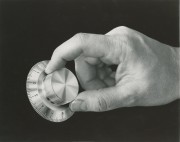Dial Unit Speeds Ore Weighing

Steelmakers base vital decisions on raw-material assays. Accurate weighing is a must. With a new dual-dial torsion balance, they get precise oresample weights in a hurry.
Fast, accurate weighing in bench scale research tests can provide key data affecting iron and steel production. Columbia-Geneva Steel Div., United States Steel Corp., uses this method to determine normal assays on blast-furnace materials.
Fine-grained pulps of iron ore. coal, coke, or limestone are continuously weighed, both before and after bench-scale tests. Samples ranging from 50 g down, get weight checks accurate to within 5 milligrams.
Management uses this weight information to reach timely decisions on reserves development, facility requirements and operating methods.
Key instrument – one important contributor to the success of this program is a new, weight-loading, torsion balance builit by The Torsion Balance Co., Clifton, N. J. This advanced dual-dial weighing instrument cuts weighing time by as much as 70 pct.
With a simple twist of a single dial, the operator weights up to 10 g in 1g increments. A dial for fine weighing has 10 milligram increments up to 1 g.
By manipulating these two dials, the operator can obtain accurate weight readings in 30 seconds. Let’s check out a typical operation with the equipment – determining the quantity of iron oxide present as magnitite in an ore sample.
Quick Yield Readings – Ore samples of 10-15 g are accurately weighted on the torsion balance. Then they’re put into a magnetic tube separator, which uses a magnetic field to retain the magnetite. After nonmagnetic materials are washed out, the residue of magnetic substance is discharged, dired, and weighed again on the torsion balance. These two weight readings pinpoint the percentage of iron-oxide recovery.
Average weighing time with the new dual-dial system is 30 seconds. It took 90 seconds to do the same task with a 1500-g, double-pan pulp balance. And the operation of this older unit required repeated arresting of the balance. Weights had to be shuffled back and forth between the pans until they came into balance. Then to get a reading, the weights had to be counted.
Fast and Simple – With the new torsion balance, weights are dialed and read off directly. There’s no need to arrest the balance. Instead, an oil dashpot quickly damps all unwanted oscillations.
As many as 150 bench-scale test weighings may be made at Columbia-Geneva’s Raw Materials Research Laboratory in one day. It’s not hard to visualize the savings in time and convenience that are possible with the new dual-dial unit. These advanced instruments provide the accurate scientific data vital to success in the competitive steelmaking industry.
Published in 1962
